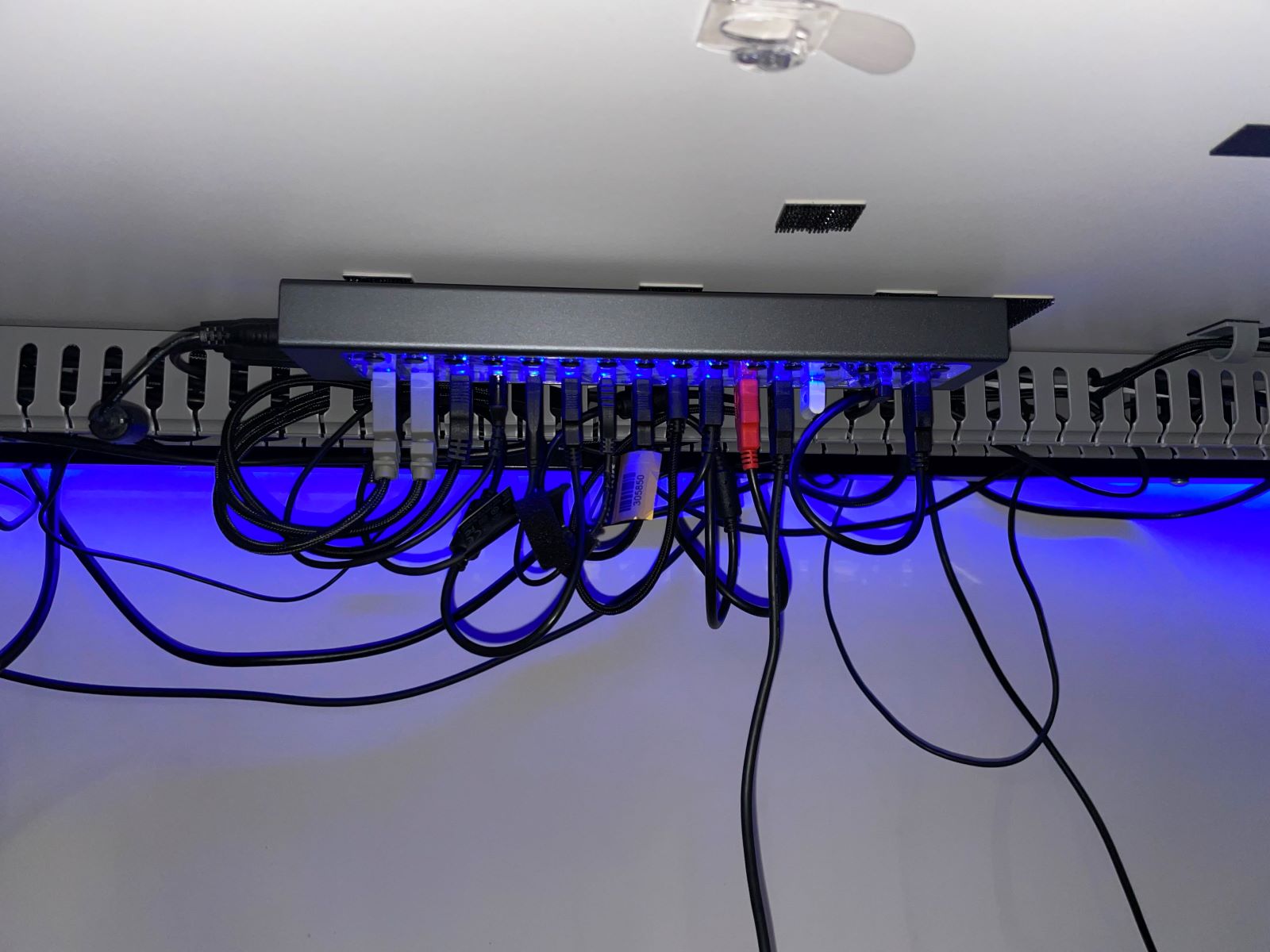USB Hub Basics
A USB hub is a convenient device that allows you to expand the number of available USB ports on your computer. It acts as a central hub, enabling you to connect multiple USB devices simultaneously. This can be incredibly useful for those who have limited USB ports and need to connect various peripherals such as printers, external hard drives, and keyboards.
USB hubs come in various shapes and sizes, ranging from small compact hubs to larger desktop models. They are typically powered either by the computer they’re connected to or have their own power source. While they may seem like a convenient solution, using a USB hub with certain devices, such as a Stream Deck, can lead to various issues that can hinder your workflow and potentially damage your equipment.
It is important to note that not all USB hubs are created equal. Some are more reliable and better equipped to handle the power and data requirements of specific devices. However, when it comes to a Stream Deck, it is generally recommended to avoid using a USB hub altogether.
Next, we will explore why using a USB hub with a Stream Deck can be problematic and explore the potential dangers and issues that can arise as a result.
What is a Stream Deck?
A Stream Deck is a powerful tool designed to enhance the productivity and convenience of content creators, gamers, and professionals who frequently use macros and shortcuts. Developed by Elgato, a leading brand in video production and streaming accessories, the Stream Deck provides customizable buttons with dynamic LCD displays. These buttons can be programmed to perform a wide range of actions, such as launching applications, triggering keyboard shortcuts, switching scenes, adjusting audio settings, and much more.
The Stream Deck comes in different models, including the Stream Deck Mini, Stream Deck, and Stream Deck XL, offering varying numbers of programmable buttons to fit different needs. It connects to your computer via USB and is operated using the Stream Deck software, which allows you to create and manage your personalized button configurations.
Content creators, whether they are streamers, YouTubers, or podcasters, can greatly benefit from the Stream Deck’s versatility and convenience. It eliminates the need to remember complex keyboard shortcuts, switch between different applications, or manually perform repetitive actions. With a simple press of a button, the Stream Deck can streamline your workflow and increase your efficiency, giving you more time to focus on creating content.
While the Stream Deck’s functionality greatly enhances productivity, it is essential to ensure that it is properly connected and powered to maximize its performance. This is where the use of a USB hub can introduce potential issues that may compromise the Stream Deck’s function and reliability. In the following sections, we will delve into the dangers and challenges that can arise when using a USB hub with a Stream Deck.
The Dangers of Using a USB Hub with a Stream Deck
While a USB hub can be a convenient solution for expanding the number of available USB ports, using one with a Stream Deck can pose several potential dangers and challenges. These include power limitations, signal interference, functionality and performance issues, potential data loss, and the risk of overheating and equipment damage.
One of the primary dangers of using a USB hub with a Stream Deck is power limitations. USB hubs have a limited power capacity that needs to be shared among the connected devices. The Stream Deck requires a sufficient power supply to operate optimally, especially if it has additional accessories and peripherals connected to it. When a USB hub is used, the available power may be spread thin among other devices, resulting in insufficient power for the Stream Deck. This can lead to a variety of issues, including buttons not responding, inconsistent performance, or the Stream Deck not functioning at all.
Signal interference is another concern when using a USB hub with a Stream Deck. USB hubs can introduce additional cables and connections, which can increase the chances of signal degradation and interference. This can cause communication issues between the Stream Deck and your computer, resulting in delayed or incorrect button actions. It can be frustrating and impact your productivity, especially during live streams or time-sensitive tasks.
Functionality and performance issues are also common when using a USB hub with a Stream Deck. The Stream Deck relies on a stable and reliable connection to function correctly. USB hubs, particularly low-quality or overloaded ones, may not provide the consistent data transfer speed and bandwidth required by the Stream Deck. As a result, you may experience laggy button responses, delayed feedback on the LCD displays, or even random disconnects, disrupting your workflow and hindering your effectiveness.
Moreover, using a USB hub with a Stream Deck can potentially lead to data loss. Unstable connections and insufficient power supply can cause unexpected data transfer interruptions and errors. If the Stream Deck relies on syncing profiles and configurations with the computer, these interruptions can result in data corruption or loss, requiring you to recreate your custom button setups. This can be time-consuming and frustrating, setting you back in your content creation process.
Lastly, there is a risk of overheating and equipment damage when using a USB hub with a Stream Deck. USB hubs themselves can generate heat, especially when multiple devices are connected, which can potentially affect the performance and longevity of the attached devices. In the case of the Stream Deck, overheating may lead to malfunctions, decreased lifespan, or even permanent damage to the device, rendering it unusable.
Given these potential dangers, it is advisable to connect the Stream Deck directly to your computer’s available USB port whenever possible. This ensures a stable power supply, minimal signal interference, and optimal performance. However, if you need to use a USB hub, it is crucial to use a high-quality hub with sufficient power capacity and reliable data transfer speeds to minimize the risks associated with using a hub with a Stream Deck.
Power Limitations
One of the primary concerns when using a USB hub with a Stream Deck is the power limitations that can arise. USB hubs are designed to distribute power among the devices connected to them, and this can result in insufficient power for the Stream Deck to operate optimally.
The Stream Deck requires a stable and sufficient power supply to function correctly. Each button on the Stream Deck has an LCD display that requires power to illuminate and display the assigned icons or labels. Additionally, if you have other accessories or peripherals connected to the Stream Deck, such as a USB microphone or an external control pad, these devices also draw power.
When a USB hub is used, the available power is divided among all the connected devices. This means that the power allocated to the Stream Deck may be limited, especially if the USB hub is also powering other power-hungry devices. As a result, the Stream Deck may not receive the necessary power it needs, leading to various issues.
Insufficient power can manifest in several ways. Buttons on the Stream Deck may not respond when pressed, or they may have delayed and unpredictable responses. The LCD displays may flicker, become dim, or turn off altogether, making it difficult to read the assigned functions. In some cases, the Stream Deck may not function at all, rendering it useless.
To mitigate power limitations, it is recommended to connect the Stream Deck directly to the computer’s USB port whenever possible. This ensures that the Stream Deck receives the full power it requires without having to share it with other devices. However, if you must use a USB hub, consider using a high-quality powered hub that can provide sufficient power to all the devices connected to it.
Before purchasing a USB hub, check its power specifications and ensure that it can deliver enough power for the Stream Deck and any other peripherals you plan to connect. It is also worth noting that USB 3.0 hubs generally provide more power than USB 2.0 hubs, so if your computer supports USB 3.0, consider opting for a compatible hub.
By addressing power limitations and ensuring that the Stream Deck receives the necessary power supply, you can prevent performance issues and ensure a seamless workflow with your Stream Deck.
Signal Interference
Signal interference is a common issue that can arise when using a USB hub with a Stream Deck. USB hubs introduce additional cables and connections between the Stream Deck and the computer, which can increase the chances of signal degradation and interference.
The Stream Deck relies on a stable and uninterrupted communication with the computer to execute button actions accurately and provide real-time feedback on its LCD displays. Any interference in this communication can result in delayed or incorrect button responses, impacting your productivity and efficiency.
Signal interference can be caused by various factors, including the quality of the USB hub and the length and quality of the USB cables used. Low-quality USB hubs may not provide proper shielding and grounding, making them more susceptible to signal interference. Additionally, longer USB cables, especially those not specifically designed for high-speed data transfer, can introduce signal degradation and impact the reliability of the connection.
Furthermore, other electronic devices and cables in close proximity to the USB hub and Stream Deck setup can also contribute to signal interference. This includes devices such as routers, monitors, wireless transmitters, or even power cords. These devices can emit electromagnetic signals that may overlap with the signals transmitted between the Stream Deck and the computer, leading to signal degradation or loss.
To minimize signal interference, it is advisable to use high-quality USB hubs and USB cables that are designed for high-speed data transfer. Look for USB 3.0 hubs, as they provide better performance and improved resistance to interference compared to USB 2.0 hubs.
Positioning your setup carefully can also help reduce the chances of signal interference. Avoid placing the USB hub in close proximity to other electronic devices or sources of electromagnetic interference. If possible, route the USB cables away from potential sources of interference and keep them as short as possible to reduce signal degradation.
Regularly inspecting and replacing any damaged or faulty USB cables can also help maintain a reliable connection and minimize signal interference. Over time, cables may become worn or frayed, which can affect signal quality and lead to intermittent connection issues. By replacing worn-out or damaged cables, you can ensure a stable and interference-free connection between the Stream Deck and the computer.
By addressing signal interference and optimizing the connection between the Stream Deck and the computer, you can enjoy a seamless experience with accurate button responses and uninterrupted feedback on the Stream Deck’s LCD displays.
Functionality and Performance Issues
Using a USB hub with a Stream Deck can result in functionality and performance issues that can impact your productivity and overall user experience. These issues arise due to the limitations of the USB hub and the potential for data transfer and bandwidth constraints.
The Stream Deck relies on a stable and reliable connection to the computer to function correctly. When a USB hub is introduced into the setup, the data transfer speed and bandwidth may be compromised. USB hubs, especially those of lower quality or overloaded with connected devices, may not provide the optimal data transfer capabilities required by the Stream Deck.
As a result, you may experience functionality issues such as laggy or delayed button responses. When pressing a button on the Stream Deck, there may be an observable delay before the action is executed, which can hinder your workflow and disrupt the flow of your content creation process.
In addition, the LCD displays on the Stream Deck may exhibit slow or inconsistent feedback, making it difficult to read the assigned functions or labels. This can cause confusion and lead to mistakes when activating specific actions or macros.
The performance of the Stream Deck can also be negatively affected when using a USB hub. Inconsistent data transfer speeds can lead to unpredictable behavior, random disconnects, or the Stream Deck not functioning at all. These performance issues can be particularly frustrating during live-streaming sessions or time-sensitive tasks when every second counts.
To mitigate functionality and performance issues, it is recommended to connect the Stream Deck directly to your computer’s USB port whenever possible. This ensures that the Stream Deck has access to the full data transfer speed and bandwidth it requires for optimal performance.
If you must use a USB hub, consider investing in a high-quality hub that offers reliable data transfer speeds and adequate bandwidth. Look for USB 3.0 hubs, as they typically provide better performance compared to USB 2.0 hubs.
Additionally, avoid overloading the USB hub with too many devices. Each device connected to the hub consumes a portion of the available bandwidth, so reducing the number of devices connected can help ensure a smoother experience with the Stream Deck.
Regularly updating the firmware and drivers of both the Stream Deck and the USB hub can also help address compatibility issues and improve functionality and performance. Manufacturers often release firmware updates that address bugs and improve the overall stability of their devices.
By taking steps to optimize the functionality and performance of your Stream Deck setup, you can enjoy a seamless experience and maximize your productivity as a content creator or professional.
Potential Data Loss
Using a USB hub with a Stream Deck can introduce a risk of potential data loss, which can be detrimental to your workflow and productivity. Data loss can occur when there are interruptions or errors during the transfer of data between the Stream Deck and the computer.
The Stream Deck relies on syncing profiles, configurations, and other settings with the computer’s software. This allows you to personalize the button assignments and functions based on your specific needs. However, when using a USB hub, there is an increased possibility of data transfer interruptions that can result in data corruption or loss.
If the connection between the Stream Deck and the computer is unstable, sudden disconnects may occur. This can disrupt the data transfer process and lead to incomplete or partial transfers, resulting in inconsistencies or errors in the Stream Deck’s configurations.
Furthermore, insufficient power supply, which can be common when using a USB hub, can also contribute to data loss. Inadequate power can cause unexpected shutdowns or malfunctions, leading to data corruption or loss. This can be especially problematic if you rely heavily on the Stream Deck and have spent a significant amount of time customizing and fine-tuning your button configurations.
To minimize the risk of potential data loss, consider connecting the Stream Deck directly to the computer’s USB port whenever possible. This ensures a more stable and reliable connection, reducing the chances of data transfer interruptions. When directly connected, the Stream Deck can establish a direct and uninterrupted line of communication with the computer, enhancing the integrity of data transfers.
If you must use a USB hub, it is crucial to use a high-quality one that offers sufficient power and reliable data transfer speeds. In addition, regularly updating the firmware of both the Stream Deck and the USB hub to the latest versions can help address any known bugs or compatibility issues and improve the stability of the data transfer process.
Lastly, regularly backing up your Stream Deck configurations and profiles is highly recommended. By creating backups, you can ensure that your customized settings are securely stored and easily recoverable in the event of data loss or corruption. This way, even if unexpected data loss occurs, you can quickly restore your Stream Deck to its previous state, minimizing the impact on your productivity.
By taking precautionary measures and addressing the potential risks associated with data loss, you can safeguard your valuable configurations and ensure a reliable and consistent experience with your Stream Deck.
Overheating and Damage
Using a USB hub with a Stream Deck can potentially lead to overheating and damage, posing a significant risk to the functionality and longevity of both the hub and the Stream Deck itself.
USB hubs, especially when hosting multiple connected devices, can generate heat. The more devices connected to the hub, the greater the strain on it, and the higher the likelihood of heat buildup. This heat can transfer to the Stream Deck, which is positioned in close proximity to the hub.
Prolonged exposure to excessive heat can have adverse effects on the Stream Deck and its components. Overheating can degrade the performance of the internal circuitry, causing malfunctions or even permanent damage. It can also shorten the lifespan of the device, leading to a decreased overall reliability and functionality.
One of the key contributors to overheating is the power supply. When a USB hub is used, the available power is shared among all connected devices, including the Stream Deck. If the aggregated power requirements exceed the capacity of the hub, it can strain the power distribution system and lead to increased heat generation.
In addition, USB hubs positioned in confined spaces or lacking proper ventilation can further exacerbate the issue of overheating. Limited airflow can trap heat, resulting in a higher ambient temperature around the hub and the Stream Deck.
To prevent overheating and potential damage, it is advised to consider the following precautions:
1. Use a high-quality USB hub that is designed to handle the power requirements of the connected devices. While it may be tempting to opt for a cheaper option, investing in a reliable hub can significantly reduce the risk of overheating and associated damage.
2. Ensure that the USB hub is placed in a well-ventilated area, allowing for proper airflow. Avoid enclosing the hub or positioning it near heat sources that can contribute to overheating.
3. Monitor the temperature of the Stream Deck and the USB hub during extended use. If the devices feel excessively hot or are displaying signs of overheating, it is essential to disconnect them from the hub immediately and allow them to cool down.
4. Consider using a powered USB hub that has its own power supply. This can help alleviate the strain on the shared power from the computer and reduce the chances of overheating.
5. Regularly check for firmware or driver updates for both the Stream Deck and the USB hub. Manufacturers often release updates that address known issues and improve the performance and stability of their devices.
By taking these preventive measures, you can protect your Stream Deck from overheating and potential damage, ensuring a longer lifespan and uninterrupted performance.
Troubleshooting Tips
Encountering issues when using a USB hub with a Stream Deck can be frustrating, but there are several troubleshooting tips you can try to resolve common problems and ensure smooth operation.
1. Connect directly to the computer: Whenever possible, connect the Stream Deck directly to the available USB port on your computer. This eliminates the potential issues associated with using a USB hub and provides a direct and stable connection.
2. Use a powered USB hub: If you must use a USB hub, opt for a powered hub that has its own power supply. This will help ensure sufficient power for all connected devices, including the Stream Deck, minimizing power-related issues.
3. Check USB hub compatibility: Ensure that the USB hub you are using is compatible with your Stream Deck. Some USB hubs may be better suited for high-speed data transfer and power distribution, reducing the chances of compatibility issues.
4. Update firmware and drivers: Check for updates for both the Stream Deck and the USB hub. Manufacturers often release firmware and driver updates to address bugs, improve stability, and enhance compatibility.
5. Inspect USB cables: Examine the USB cables connecting the Stream Deck to the USB hub or computer. Look for any signs of damage or wear, such as frayed wires or loose connectors. Replace any faulty cables to ensure a reliable and uninterrupted connection.
6. Manage power distribution: Be mindful of the power requirements of all devices connected to the USB hub. If there are power-hungry devices connected, consider disconnecting some peripherals to alleviate the strain on the hub and ensure sufficient power for the Stream Deck.
7. Check for signal interference: Arrange your setup to minimize potential signal interference. Avoid placing the USB hub near sources of electromagnetic interference, such as routers or wireless devices. Position the cables away from other cables and electronic devices to reduce the chances of signal degradation.
8. Restart the devices: Sometimes, a simple restart can resolve temporary glitches. Restart both the Stream Deck, the USB hub, and your computer to clear any temporary issues that may be affecting their performance.
9. Reset Stream Deck settings: If you are experiencing persistent issues, you can try resetting the Stream Deck settings to their defaults. Use the Stream Deck software to initiate the reset, and then reconfigure your buttons and profiles as needed.
10. Contact support: If all else fails, reach out to the support team of the Stream Deck or the USB hub manufacturer. They can provide further assistance and troubleshoot any specific issues you may be experiencing.
By following these troubleshooting tips, you can effectively address common issues and maintain a reliable and functional setup with your Stream Deck and USB hub.




